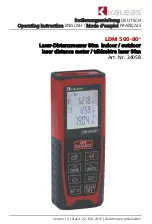
Appendix D
161
Caring for Connectors
Making Connections
Final Connection Using a Torque Wrench
When the preliminary connection has been made, use a torque wrench to make the
final connection. Tighten the connection only until the “break” point of the wrench
is reached, when the wrench handle gives way at its internal pivot point. Do not
tighten the connection further.
Also make sure that torque actually is being applied to the connection through the
torque wrench, not only to the wrench handle or in any way that prevents the break
point of the wrench from controlling the torque applied to the connection.
Suggestions to ensure that torque is actually being applied are given in Table D-2 on
page 162.
Using a torque wrench guarantees that the connection will not be too tight, thus
preventing possible damage to the connectors and impaired electrical performance.
It also guarantees that all connections will be made with the same degree of
tightness every time they are made.
Torque wrenches pre-set to the correct value for each connector type are included in
many Agilent calibration kits, and they are also available separately. Torque settings
are detailed in Table D-2.
When using a torque wrench, prevent rotation of anything other than the connector
nut that is being tightened with the torque wrench. Generally this is easy to do by
hand (all the more so if one of the connectors is fixed) as on a test port. In other
situations, an open-end wrench can be used to keep the bodies of the connectors
from turning.
Hold the torque wrench lightly by the knurled end of the handle only. Apply force at
the end of the torque wrench only, perpendicular to the wrench and always in a plane
parallel to the outer conductor mating planes. This will result in torque being applied
to the connection through the wrench until the break point of the wrench is reached.
Avoid pivoting the wrench handle on the thumb or other fingers. This results in an
unknown amount of torque being applied to the connection when the break point of
the wrench is reached. Avoid twisting the head of the wrench relative to the outer
conductor mating plane. This results in applying more than the recommended
torque.
Содержание NFA Series
Страница 25: ...13 2 Test Descriptions This chapter descibes each test required for calibration and performance verification...
Страница 114: ...104 Chapter3 Technical Specifications General Specifications...
Страница 126: ...116 AppendixA Model N8973A Test Records Measurement Jitter Test Record...
Страница 138: ...128 AppendixB Model N8974A Test Records Measurement Jitter Test Record...
Страница 152: ...142 AppendixC Model N8975A Test Records Measurement Jitter Test Record...
Страница 178: ...168 AppendixD Caring for Connectors Principles of Microwave Connector Care...
Страница 184: ...174 Index Index...














































